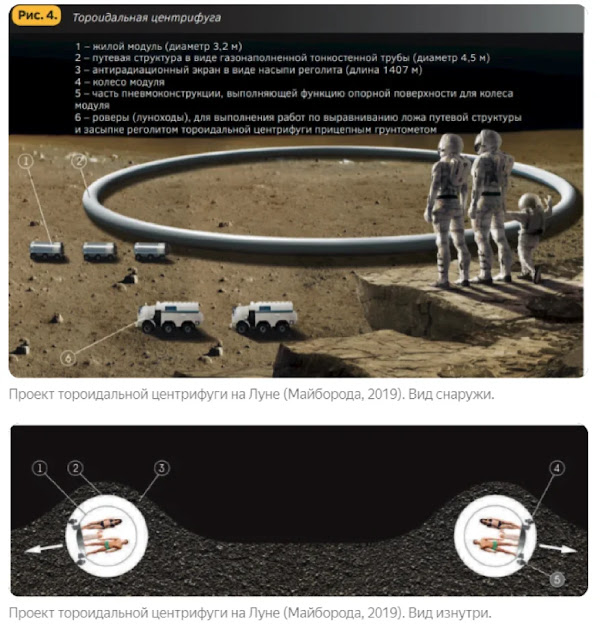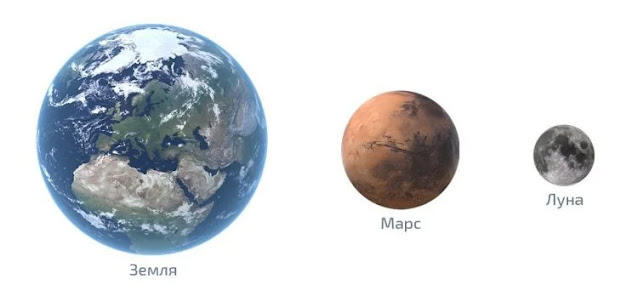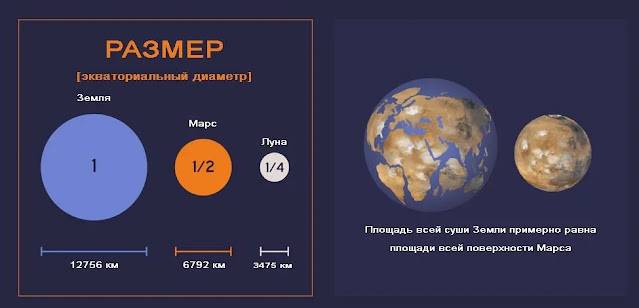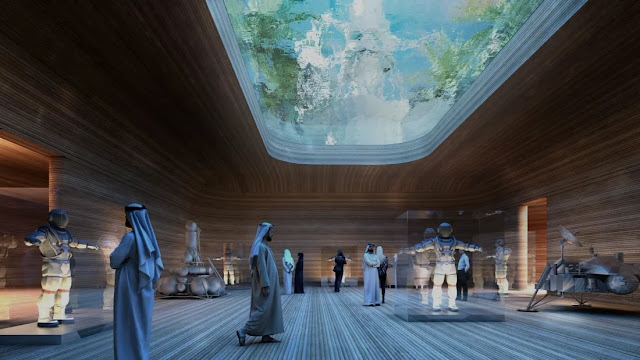Space Expansion logo.
July 4, 2021
Preamble
Here the eighteenth (18.5) article of a series of articles by Ph.D. Morozov Sergey Lvovich, expert in chronology and calendar systems, as well as space biology and medicine, Parliamentarian of Asgardia (AMP) the first space Nation.
Ph.D. Morozov Sergey Lvovich
TOROIDAL STATIONARY LUNAR SPACE ARK MAYBORODA WITH ARTIFICIAL GRAVITY OF THE EARTH LEVEL
Wernher von Braun (Von Braun, W .: Crossing the Final Frontier, Colliers, March 22, 1952) presented a well-calculated mobile spacecraft in a modular Stanford Torus version, in a more detailed version representing the concept of an annular rotating space station.
It was a torus (ring) with a diameter of about 1.8 kilometers, which rotated around its axis with an angular velocity of one revolution per minute, creating an artificial earth-level gravity on the ring in the amount of 0.9 - 1.0 g due to the centrifugal force of rotation.
The ring is connected to the hub through "spokes" -corridors for the movement of people and goods to the axle and back. The hub - the axis of rotation of the station - is best suited for the docking station for receiving spaceships, since artificial gravity is negligible here: there is a stationary transport module docked to the axis of the station. The inner space of the torus is residential, it is large enough to create an artificial ecosystem.
Within the ring will function as branches for farming and the actual residential part.
The option of placing a similar, but stationary "Homeostatic Ark [GK]" on the Moon was first proposed to be implemented in 2019 by the director of the research company AVANTA-Consulting LLC, Rostov-on-Don, Russia, Mayboroda A.O. in his publication.
Image above: Mayboroda Alexander Olegovich, director of the research company AVANTA-Consulting LLC.
Mayboroda A.O. writes: “Reproduction of the usual conditions of existence is possible with the construction of a centrifuge as part of the lunar base to create artificial earth-level gravity, with simultaneous protection from solar and galactic radiation and the generation of a magnetic field with earth parameters.
With the reproduction of typical terrestrial conditions, the stay of people on the moon can be increased from the planned 1-3 months to 12-36 months. Thus, the creation of long-term bases on the Moon requires their implementation in the form of centrifuges (that is, in the form of stationary GCs, - SM).
Real life is often ahead of the boldest predictions. In 10 years, in 2030, the first stationary homeostatic arks with maglev centrifuges on a magnetic levitation will most likely become the basis of any long-term living station on the Moon.
Image above: The first project of the stationary lunar homeostatic ark (GC) Mayboroda A.O. (2019) axial type.
Images above: The second project of the stationary lunar homeostatic ark (GC) Mayboroda A.O. (2019) toroidal type.
FIRST MAN BORN IN A HOMEOSTATIC ARK (HA) IN SPACE BY NATURAL WAY
It is not excluded that the first man in space will be born naturally after 10 years on the Moon in the comfortable conditions of artificial earth-level gravity on a stationary lunar GC. The moon will eventually become a kind of "incubator" for the rapidly emerging "space humanity"?
Image above: The author of the term "space" man [2020] is the test cosmonaut S.V. Krichevsky. Russian test cosmonaut, candidate of technical sciences (1987), doctor of philosophy (2009), professor (2012).
The conditions on the stationary lunar GC for the birth and upbringing of children will be exactly the same as on Earth. It is not excluded that the first "lunar people" will simultaneously become the first individuals of "cosmic" humanity [9] who will live in space from birth to death throughout their entire life cycle.
Their home will be the stationary or mobile GC on which they were born and raised.
The Earth will be one of the possible variants of a stationary GC with a natural gravity equal to 1.0 g, on which a space man can also live permanently, as on an ordinary stationary GC.
Framework Agreement between IBMP RAS and Asgardia Terra Ark (Earth Ark of Asgardia)
To create conditions for a full-fledged human life in space and for the birth of the first child outside the Earth.
Image above: Director of the Institute of Biomedical Problems of the Russian Academy of Sciences Oleg Orlov at a meeting with the Head of the Space Nation Igor Ashurbeyli.
On June 18, 2021 (1 Leo, 0005), on the Day of Unity of Asgardia, the Head of the Space Nation Igor Ashurbeyli and the director of the Institute of Biomedical Problems of the Russian Academy of Sciences Oleg Orlov signed a framework agreement, which marked the beginning of long-term partnership and joint projects in the field of space science.
Asgardia Terra Ark (Earth Ark of Asgardia) is a competent international non-governmental organization for the development, design and implementation of various scientific research in the field of the aerospace industry.
"The scientific aspirations of the Institute for Biomedical Problems coincide with the goals of the Space Nation, whose main mission is to create conditions for a full-fledged human life in space and for the birth of the first child outside the Earth. The conclusion of the Agreement with the IBMP is an important strategic step on this path.
The Institute for Biomedical Problems is the world leader in space medicine. A whole galaxy of famous scientists works in it. These are the students and successors of the people who prepared the first manned flights. And now the institute is focused on the development of methods and technologies for human adaptation to a long stay in low orbit, in which Asgardia is most interested in the next 20 years.
We entered into an Agreement with the Institute in the year when mankind celebrates the 60th anniversary of the Vostok-1 flight. This is a good symbolism for the start of long-term and productive cooperation, ”commented the Head of the Space Nation Igor Ashurbeyli.
“The Institute for Biomedical Problems highly appreciates the prospects of cooperation with Asgardia Terra Ark as an organization that successfully implements activities in the field of popularizing cosmonautics, as well as actively involving scientists from all over the world in space activities,” said the Director of the Institute, Academician Oleg Orlov. “We hope that the conclusion of this Agreement will allow us to expand the range of international projects aimed at preparing for deep space exploration, and to enrich the network of contacts between the involved scientists and specialists in the field of space biology and medicine.
Successful interaction between IBMP and Asgardia NGO can become a platform for constant exchange of experience and ideas."
The child is a symbol of the Future
WHY ON FEBRUARY 14, 2021, ILON MASK CONTACTED THE OFFICIAL TWITTER ACCOUNT OF THE PRESIDENT OF RUSSIA PUTIN?
WHY ELON MASK DECIDED TO COLONIZE THE MOON BEFORE THE COLONIZATION OF MARS?
WHY IS THE COLONIZATION OF THE MOON, MARS AND OPEN SPACE IMPOSSIBLE WITHOUT ATOMIC ENERGY?
Elon Max believes that the most important task for himself is the achievement of the status of an "interplanetary species" by human civilization, when more than one planet will be inhabited by people.
However, today a colony on Mars will not survive without constant support from Earth. She will not be able to become self-sufficient in terms of energy. The efficiency of solar cells in the orbit of Mars is limited by the density of solar study, which is 2.3-2.7 times less than in the orbit of the Earth and is directly dependent on the value of the "solar constant", which characterizes the strength of the radiation of the sun itself at a given distance from its center ( in astronomical units - 1 AU = 149.59 million km; in SI units = 149 597 870 700 meters).
Schematic representation of the Earth's orbit
The Earth's orbit is the trajectory of the Earth around the Sun at an average distance of about 149.6 million kilometers (152.1 million km in aphelion is the semi-major axis of the ellipse; 147.09 million km at perihelion is the semi-minor axis of the ellipse).
In the first approximation, the Earth's orbit has the shape of an ellipse and is described by Kepler's laws.
One orbital revolution, the so-called sidereal year (a complete revolution of relatively distant "fixed" stars), lasts 365.256 days.
Do not confuse the terrestrial sidereal (that is, "stellar") year (the time of one revolution of the Earth around the Sun relative to "fixed" distant stars) and the tropical year (the time during which all seasons change in the Tropic of Cancer during the summer solstice or in the Tropic of Capricorn during the winter solstice).
They differ from each other: the sidereal year is about 20 minutes longer than the tropical year (this difference is mainly due to the precession of the earth's axis).
The barycenter (center of gravity or center of mass) of the Earth-Moon system moves from west to east at an average speed of 29.78 km / s (about 107,200 km / h), covering more than 940 million km in a sidereal year.
In physics, the term "barycenter" can mean the mathematical center of mass or center of gravity, depending on the context.
The physical center of mass (and the center of gravity in a constant gravitational field) is the mathematical arithmetic mean of all points in a physical system, taking into account local density or specific gravity.
If a physical object has constant density, then its center of mass coincides with the mathematical barycenter of a figure of the same shape.
In the modern era, the Earth passes perihelion from January 2 to 5, aphelion - from July 1 to 5.
The astronomical unit (Russian designation: au; international: since 2012 - au; previously the designation ua was used) is a historically established unit of measurement of distances in astronomy.
The astronomical unit was initially assumed to be equal to the average semi-major axis of the Earth's orbit, which in astronomy is averaged by the value of both semi-axes of the ellipse [(152.1 + 147.09) / 2 = 149.59 = 149.6 million km] is considered the "average" distance from the Earth to The sun.
Distance from the Sun to the Earth, corresponding to 1 astronomical unit
Schematic representation of the orbits of the terrestrial planets: the white line indicates the distance from the Sun to the Earth, corresponding to 1 astronomical unit.
The value of the "solar constant" for the Earth and the planets of the solar system.
"Solar constant" (E 0) of the Earth is the power of solar irradiation of the Earth in watts - "W", - on average, - at the average distance from the Earth to the Sun, measured in Astronomical Units (1 AU = 149.59 million km), without the influence of the atmosphere, strictly perpendicular to the direction of radiation per unit area (in "m2").
(https://deru.xcv.wiki/wiki/Solarkonstante)
The moon is always equally illuminated by the sun, but unequally close to it. In the first and third quarter phase, the Moon is at a distance of about 1 AU. from the Sun, like the Earth;
In the full moon phase - on average 384,400 km (384,000 km is 0.0026 AU) further (receives 0.5% less solar energy), and in the new moon phase on average 384,400 km closer (receives 0, 5% more solar energy).
(https://easy-physic.ru/6594-2/)
Graphic above: The following table shows the solar constants for the planets and some other celestial bodies of the solar system: https://deru.xcv.wiki/wiki/Solarkonstante
Martian sandstorms reduce the transparency of the Martian sky, further reducing the efficiency of solar panels on the surface of Mars.
Comparison of the sizes of the Moon, Earth and Mars
Image above: The area of the entire land area of the Earth is approximately equal to the area of the entire surface of Mars. By volume: The Earth is 2 times the size of Mars and 4 times the size of the Moon. Mars is 2 times the size of the Moon.
At the equator of Mars, the highest temperatures reach + (20-27) ° С (up to + 35 ° С), and at the poles they fall to -120 ° С (up to -125 ° С). Average maximum: -5.7 ° C. Average daily value around (-40 ° C / -60 ° C / -63 ° C). Water disappeared with the advent of the Amazonian era. Remains of moisture are presented in the form of polar caps of water ice.
Modern solar panels, with their limitations, are not able to consistently provide the high energy requirements of the Martian colonies for the production of local products from Martian raw materials and the comfortable living conditions of the colonists at low temperatures.
The average temperature on the Earth's surface is + 14 ° С. In the area of the Vostok station in July 1983, the temperature dropped to - 89.2 ° С (-93.2 ° С). In 1913, in Death Valley in the United States, the air warmed up to + 56.7 ° C. In the Deshte-Lut desert in 2005 the temperature reached + 70.7 ° С.
It is necessary to build an expensive, costly, constantly operating, unprofitable conveyor to supply the colonists with everything they need along the line: Earth-Moon-Mars.
Energy nuclear technologies of the corresponding power in deep space are indispensable. But they are not there today.
- Only Russia is currently developing a megawatt-class space reactor, the electric power of which will help solve a huge number of problems associated with the colonization of Mars and its material support, both on the planet itself and in outer space.
- But for this, Musk needs either to negotiate with Russia, or to postpone the colonization of Mars for a long time due to the high probability of death due to the energy failure of the project.
- Or Musk himself will engage in deep modernization of the nuclear industry in the USA, France, Great Britain, Germany, Japan, etc., providing his project with his own nuclear reactors.
Man, of course, will colonize Mars someday. But this will happen only after the successful development of space nuclear energy technologies on the Moon, and the wide development of space automatic transport transfer stations for supply.
The UAE has set itself the goal of becoming a modern space nation. The Mohammed bin Rashid Dubai Space Center (MBRSC) opens in Dubai.
To this end, the UAE is creating a Martian city on earth and has successfully sent its spacecraft to Mars, which is already in its orbit.
The question is, how will the UAE deliver its space city to Mars? (and the Moon?)
Dubai Mohammed bin Rashid Space Center (MBRSC)
Dubai Mohammed bin Rashid Space Center (MBRSC)
Dubai Mohammed bin Rashid Space Center (MBRSC)
Dubai Mohammed bin Rashid Space Center (MBRSC)
Currently, there is no consensus on what will save the world: the so-called green energy (in the winter of 2020-2021, the "green" Texas and other "green" states froze) in the United States, or nuclear reactors?
Moreover, the lobby of nuclear reactors is also quite powerful. For example, Jeff Bezos invested $ 65 million in Canadian nuclear startup General Fusion. General Fusion wants to make the world's energy supply clean, safe, but fusion-fueled.
(https://zen.yandex.ru/media/zgj/kosmicheskaia-triada-rossii--proekt-nuklon-ross-i-lunnaia-stanciia-6084371e924e08292f1d3ea9)
What new technologies are needed for long space travel? Bezos: “I think NASA should be working on a space nuclear reactor. If we really want to go somewhere outside Mars, then we need atomic energy for this. "
All this, including the methods of radiation protection, will be tested first on the Moon. Therefore, there is no need to wait for a safe settlement of Mars in the near future.
Elon Musk is well aware that the failure of a poorly organized mission with a flight to Mars will be a blow to his own image and the image of his company, so he is looking for the correct way out of the situation.
Ships "Starship" on the Moon and Mars as presented by the artist
Therefore, probably, until these problems are resolved, Elon Musk postpones his flight to Mars indefinitely and gives priority to the colonization of the Moon using space nuclear reactors of the megawatt class, which he would like to receive from Russia?
His reusable Starship-class ships are perfect today for colonizing the moon and supplying crowded lunar bases.
The "satellite" of the Earth - the Moon has a structure similar to it. The average distance between the centers of the Earth and the Moon is 384,467 km.
- Weight: 7.35 × 10²² kg
- Average temperature: -23.1 ° C
- Second space velocity: 2.38 km / s.
The Moon makes a physically complex, imperfectly accurate from the point of view of mathematics, an apparent complete revolution around its axis (from the point of view of an observer on the Sun) in about 27 days (27.3 days). A day on one side of the Moon lasts about 13.5 days (324 Earth hours), and for the next 13.5 days it is plunged into darkness.
During the same 27 days (27.3 days), the Moon makes a complete revolution around the Earth. Therefore, the Moon is always turned to the Earth by the same side. 0.3 days (days) accumulate due to the "libration" of the edges of the moon.
Libration (from Lat. Lībrātiō - "rocking") is a slow oscillation (real or apparent) of the satellite, observed from the surface of the body around which it revolves. Without further clarification, the word "libration" usually means the apparent oscillatory motion of the moon when viewed from Earth.
Although the period of the Moon's revolution around the Earth is equal to the period of its revolution around its axis, libration allows an observer from Earth to see the lunar disk at different times in slightly different positions. Thus, in total from the Earth, not mathematical exact 50%, but real physical 59% of the lunar surface can be observed.
There are four types of libration: longitude, latitude, daily libration, and physical libration.
The libration period in longitude gives an anomalous month.
The period of libration in latitude gives a draconian month.
For an observer from Earth, the day is always full. Therefore, the visible lunar cycle ("lunar month") consists of the sum of full: 14 + 14 = 28 Earth days (336 hours + 336 hours = 672 hours).
A new moon (a moonless night), when the Moon completely disappears from view for an observer from Earth, is 1.5 days (36 hours).
Total: full lunar cycle ("molad interval") for the observer
from the Earth is: 28 + 1.5 = 29.5 days (29 days 12 hours 44 minutes + 1/18 minutes) or a full 708 hours (672 + 36 = 708).
The Earth and the Moon rotate together in the same direction counterclockwise. The Earth rotates under the Moon counterclockwise around its axis, completing one full revolution in exactly 24 hours (in one day or exactly 1440 minutes) from the point of view of an observer on Earth.
But the Moon itself moves in its orbit in the same direction, also counterclockwise, that is, from the point of view of an observer from the Moon, the Moon "runs away" (ahead) from objects on Earth during the day 40 minutes ahead. Accordingly, the Earth "lags behind" objects on the Moon for each revolution of its rotation by 40 minutes.
Therefore, the total terrestrial day for an observer on the moon lasts: 24 hours 40 minutes, - 1480 minutes (1.028 times longer than "true terrestrial"). Mathematically, 27.756 days pass on Earth (27 days * 1.028 = 27.756).
Physically, this is exactly 28 visible (apparent) lunar days for an observer on Earth (due to the relative joint motion of the Moon and Earth in one direction counterclockwise).
Here the "principle of complementarity" of mathematical and physical data takes place (this "principle of complementarity" was substantiated by Niels Bohr).
"When sunlight hits the surface of the moon, temperatures can reach +127 ° C. After sunset, it can drop to minus -173 ° C. Temperature changes across the entire surface of the moon, as it revolves around the earth and around its axis.
At a depth of 1 meter from the surface throughout the Moon, there is always and everywhere a uniform constant temperature of -35 ° C, since the Moon has a source of natural heat from its core.
The thickness of the lunar crust is on average 68 km, varying from 0 km under the lunar sea of Crises to 107 km in the northern part of the Korolev crater on the reverse side.
Images above: The internal structure of the moon is fundamentally almost no different from the earth.
Beneath the crust is a mantle and a small core of iron sulfide (about 340 km in radius and 2% of the mass of the Moon).
The core temperature is believed to be between + 1327 ° C and + 1427 ° C.
The core heats the inner layer of the molten mantle, but it is not hot enough to heat the entire thickness of the moon to the very surface and melt the ice.
But this heat is quite enough to maintain a constant permafrost temperature of -37 ° C at a depth of 1 meter from the surface of the Moon.
Going deeper into the crust and the upper layer of the lunar mantle, it is possible to achieve a natural, constant, stable comfortable temperature for the lunar station + (22-30) ° C during the construction of the lunar stationary GC. and it will not need to be specially heated.
This will significantly reduce the cost of operating the lunar base in its sublunar version with a full-fledged earth-type atmosphere in all completely sealed living quarters of the lunar base.
On the moon, it is likely that there is oil and gas, and the whole range of basic minerals that we have today on Earth.
In this sense, the Moon is almost a "complete twin" of the Earth?
Related article:
Visions of the Future
https://orbiterchspacenews.blogspot.com/2021/06/visions-of-future.html
Related articles (archives):
Exodus of civilization into space - American Jobs Plan. Part 18.4
https://orbiterchspacenews.blogspot.com/2021/06/exodus-of-civilization-into-space.html
Exodus of civilization into space - The space age of civilization began its new Third stage (civil). Part 18.3
https://orbiterchspacenews.blogspot.com/2021/06/exodus-of-civilization-into-space-space.html
Exodus of civilization into space - Selenic Strategy - Ideology of the UN in the XXI Century. Part 18.2
https://orbiterchspacenews.blogspot.com/2021/05/exodus-of-civilization-into-space_31.html
Exodus of civilization into space - Selenic Strategy - UN Ideology in the XXI Century. Part 18.1
https://orbiterchspacenews.blogspot.com/2021/05/exodus-of-civilization-into-space_25.html
Space Toilet and Problems of Intestinal Stick Infection. Part 17.7
https://orbiterchspacenews.blogspot.com/2021/05/space-toilet-and-problems-of-intestinal.html
Three Historical Stages of Cosmonautics Development. Part 17.6
https://orbiterchspacenews.blogspot.com/2021/05/three-historical-stages-of-cosmonautics.html
Brief Background to Selenopolitics (Industrial Colonization of the Moon). Part 17.5
https://orbiterchspacenews.blogspot.com/2021/05/brief-background-to-selenopolitics.html
Exodus of civilization into space - Creation of the first ever mobile homeostatic ark (HA) in the USA. Part 16
https://orbiterchspacenews.blogspot.com/2021/05/exodus-of-civilization-into-space_5.html
Exodus of civilization into space - Apocalypse; View from the UK. Part 15
https://orbiterchspacenews.blogspot.com/2021/05/exodus-of-civilization-into-space_3.html
Exodus of civilization into space - Comparison of plans of NASA and Roscosmos. Part 14
https://orbiterchspacenews.blogspot.com/2021/05/exodus-of-civilization-into-space.html
The ideology of space expansion - The question of pregnancy and childbirth in zero gravity. Part 17.4
https://orbiterchspacenews.blogspot.com/2021/04/the-ideology-of-space-expansion.html
Colonization of the Moon - The source of the power, wealth and power of civilization in the Universe. Part 17.3
https://orbiterchspacenews.blogspot.com/2021/04/colonization-of-moon-source-of-power.html
Space manned industrialization of the XXI century - the golden age of civilization. Part 17.2
https://orbiterchspacenews.blogspot.com/2021/04/space-manned-industrialization-of-xxi.html
Exodus of civilization into space - Humanity's strategy to create stationary and mobile Homeostatic arks. Part 17.1
https://orbiterchspacenews.blogspot.com/2021/04/exodus-of-civilization-into-space_21.html
Exodus of civilization into space - Tsiolkovsky Galactic State. Part 9
https://orbiterchspacenews.blogspot.com/2021/04/exodus-of-civilization-into-space_19.html
Exodus of civilization into space - Symbol of the End of the XXI century. Part 8
https://orbiterchspacenews.blogspot.com/2021/04/exodus-of-civilization-into-space_16.html
Exodus of civilization into space - Stopping the process of increasing value added. Part 7
https://orbiterchspacenews.blogspot.com/2021/04/exodus-of-civilization-into-space_14.html
Exodus of civilization into space - The sixth socio-economic formation of civilization. Part 6
https://orbiterchspacenews.blogspot.com/2021/04/exodus-of-civilization-into-space-sixth.html
Exodus of civilization into space - Space man. Part 5
https://orbiterchspacenews.blogspot.com/2021/04/exodus-of-civilization-into-space-space.html
Exodus of civilization into space - Biological End of the World. Part 4
https://orbiterchspacenews.blogspot.com/2021/04/exodus-of-civilization-into-space_7.html
Exodus of civilization into space - Geochronological Ice Ages, periods, eras. Part 3
https://orbiterchspacenews.blogspot.com/2021/04/exodus-of-civilization-into-space_5.html
Exodus of civilization into space - Astrophysical End of the World. Part 2
https://orbiterchspacenews.blogspot.com/2021/04/exodus-of-civilization-into-space.html
The ideology of space expansion - Space calendar. Part 1
https://orbiterchspacenews.blogspot.com/2021/03/the-ideology-of-space-expansion-space.html
Related links:
About Ph.D. Morozov Sergey Lvovich: https://zen.yandex.ru/media/id/5fbb90753e3ad265054f930a/ob-avtore-kanala-5fbd2bf80b4af80149fb12c2
Original article in Russian on Zen.Yandex:
https://zen.yandex.ru/media/id/5fbb90753e3ad265054f930a/ishod-civilizacii-v-kosmos-chast-18-selenostrategiia-ideologiia-oon-v-xxi-veke-60a51f9b9582641d181888d9
Asgardia website: https://asgardia.space/
Author: Ph.D. Morozov Sergey Lvovich / Zen.Yandex. Editor / Translation: Roland Berga.
Greetings, Orbiter.ch





















